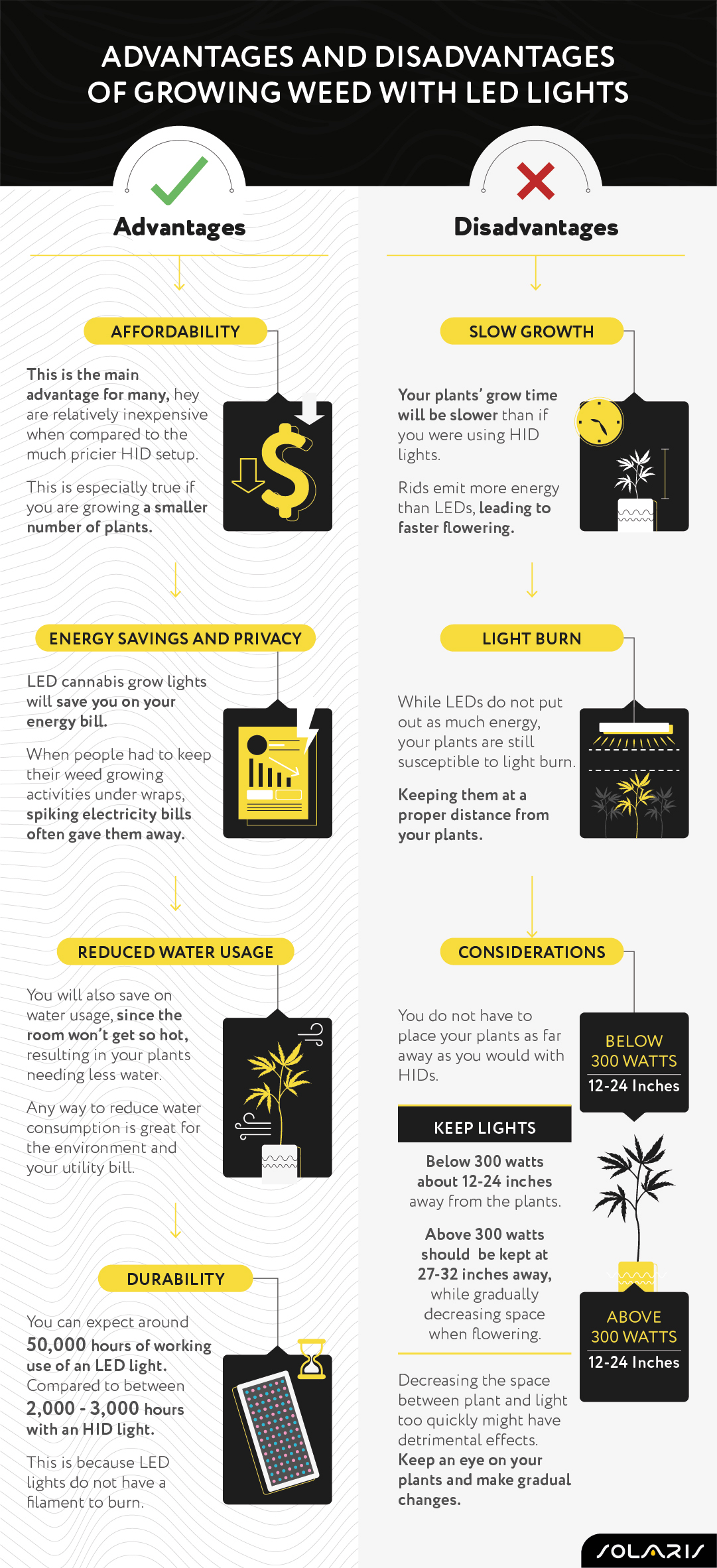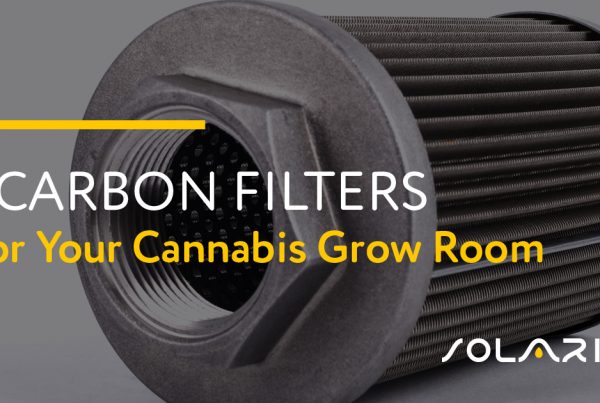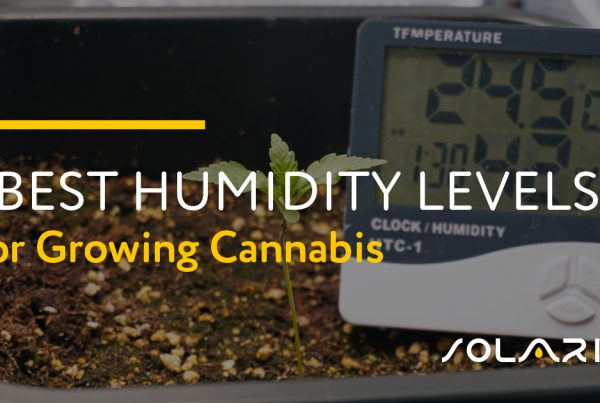When creating an indoor setup for growing cannabis, one of the most important decisions is what kind of lights to use. It used to be that lighting was one of the most expensive aspects of growing. A good set of HID or CFS lights could set you back a couple hundred with all the required equipment.
Now, thanks to LEDs, cannabis grow lights are much more affordable, making growing weed at home much more attainable. Light-emitting diode (LED) grow lights have not always been popular with growers. However, technology has improved, and so have LED lighting systems.
Although they would not have been a reasonable choice for weed growers five or ten years ago, they are becoming more popular every day.
Different types of grow lights
The main types of cannabis grow lights are HID, or high-intensity discharge, CFL or compact fluorescent lights, and of course, LED lights. HID lights were the most commonly used cannabis grow lights when indoor growing first became popular in the 1990s. This was because they produced just the right number of lumens to grow cannabis indoors.
Though they work exceptionally well, HID lights are not without issues. For instance, a good setup is very expensive. If your plants do not produce to your liking, you could find yourself out a few hundred dollars with no way to make your money back.
Those who could not afford a good set of HIDS would often resort to CFLs, which are not as effective during the flowering phase but nonetheless got the job done. Oftentimes, these were the only options for growers with smaller operations, or those growing a couple of plants for personal use.
CFLs have gained some popularity over the years, but they would never be as popular as HID lights, which are trusted by growers all over the world. That is until LED lights began to take over.
How do LED lights work?
Most simply, LED lights use a current passing through a semiconductor to produce light. The energy (in the form of light) is released from moving electrons inside the semiconductor. They used to only be available in red, but now they are available in any color, ranging from ultraviolet to infrared wavelengths.
The invention of LED lights is credited to H. J. Round, a British man from Marconi Labs who, in 1907, was the first to experiment with, and observe electroluminescence. Fast forward twenty years to when the actual invention of the first LED light finally came about.
But even the Russian inventor, Oldeg Vladimirovich Losev, could not find a practical way to use the light. It was not until 1955 that Rubin Braunstein observed semiconductor alloys, and six years later, Texas Instruments took over with a patent.

Advantages of using LED lights
Many growers are making the switch to LED lights and for good reason. There are many advantages to using LED lights when growing cannabis.
- Affordability: For many, the main reason is that they are relatively inexpensive when compared to the much pricier HID setup. This is especially true if you are growing a smaller number of plants. This was not always the case. When LEDs were first gaining momentum among growers, the technology was still fairly new and had not entirely been perfected. Think about how expensive and inconvenient cutting-edge technology like smartphones were when they first came out, and it often was not worth it but now they are everywhere. LEDs had a similar path to relevance.
- Energy savings and privacy: Another thing to consider is how much money LED cannabis grow lights will save you on your energy bill. HID lights are good at what they do, but the amount of energy they use will cause your energy bills to skyrocket. This not only hurts your pocketbook, but it can also draw unwanted attention in your direction either by a landlord and/or the police. When people had to keep their weed growing activities under wraps, spiking electricity bills often gave them away.
- Reduced water usage: Not only are LED lights more energy-efficient, but you will also save on water usage as well. HID lights use a lot of energy, which in turn produces more heat. This dramatically increases the temperature of the grow room, causing your plants to consume more water. Cannabis is already quite the water hog when compared to other plants and growing even just a small amount of plants uses a lot of water. Any way to reduce water consumption is great for the environment and your utility bill.
- Durability: They also last a lot longer. You can expect around 50,000 hours of working use of an LED light, compared to between 2,000 and 3,000 hours with an HID light. This is because LED lights do not have a filament to burn.
Disadvantages of LED lights
If there is one drawback of using LED grow lights, it is that your plants’ grow time will be slower than if you were using HID lights. Again, this is because HIDs emit more energy than LEDs, leading to faster flowering.
You should also be aware that while LEDs do not put out as much energy, your plants are still susceptible to light burn. So, like any other lights, make sure that you are keeping your lights a proper distance from your plants.
With LEDs, you do not have to place your plants as far away as you would with HIDs. Keep lights below 300 watts about 12-24 inches away from the plants. Lights above 300 watts should be kept at 27-32 inches away, while gradually decreasing space when flowering. Be careful when making any changes to your light setup. Decreasing the space between plant and light too quickly might have detrimental effects. Keep an eye on your plants and make gradual changes.
Color accuracy
In preparing to grow cannabis and to provide appropriate lighting, it is also vital for the grower to consider spectrum vs. CRI vs. R9. Full-spectrum lighting provides different wavelengths of light that affect the growing cycle differently. For example, 500 nanometers (nm) to 600 nanometers is vital for vegetative and seedling development, while 280 nm to 400 nm exposes the plants to UV light. Just as in humans, too much UV light can damage the plants.
Color Rendering Index (CRI) is an often misunderstood metric of color quality. Yet, for any application where color appearance is important, CRI consideration is critical. CRI is used to measure (from 1 to 100) how accurately a light source provides color to the area it covers.
Several years ago, an LED light that registered 85+ on the CRI was thought to be top of the line. Today, however, LED lights must measure 95+ to be considered excellent. To calculate the CRI of an LED, the rating for all the individual colors is taken, and then an average is given for colors R1–R8. The CRI does not calculate R9, which is red. Therefore, the most efficient LED lights have a high CRI and high R9 value, as red light is essential in horticulture and cannabis lighting.
Color temperature
Growers must also consider the Kelvin temperature used when growing cannabis plants. Degrees Kelvin is used to measure how hot or cold a light source is. The measure is not related to the actual physical temperature, it is related instead to the visual light temperature. For example, the higher the Kelvin temperature, the cooler (blue) light is. If a light has a low Kelvin temperature, it is considered to be warm. Low Kelvin temperatures are also described as being orange, like a sun setting.
Different Kelvin temperatures affect the growing cycle of cannabis in varying ways. Therefore, there are ideal temperatures to use at certain times. For flowering and the fruiting stage of growth, a grower would want to use 2700 degrees Kelvin. This temperature will create a more warm light with red tones, and this is most optimal for flowering.
For the vegetative stage of growth, 5000 degrees Kelvin is the most appropriate as this creates a cool light that is closest to daylight.
Keep in mind that the above Kelvin temperatures are only suggestions and guidance to help with growing. Many growers have reported success when using temperatures outside of these ranges. Each grower should work with his plants and bulbs to determine what temperatures work best to assist with the various growth stages.
What is most important is to have quality LED bulbs that can provide a full spectrum light source for your cannabis growing operation. Newer LED lights will give a light output that is the closest to natural sunlight and will have no gaps in the light spectrum. This will ensure that your cannabis plants have access to the full spectrum of light that they need to grow strong and healthy.


